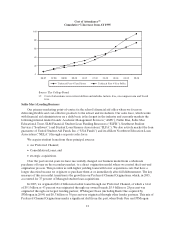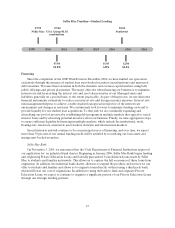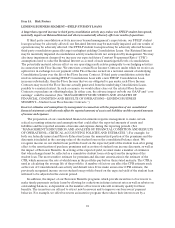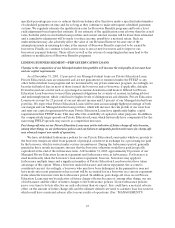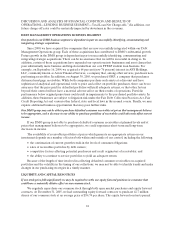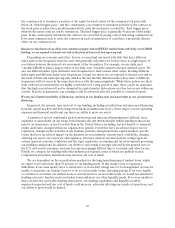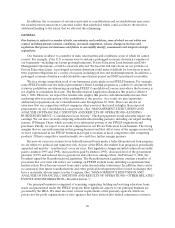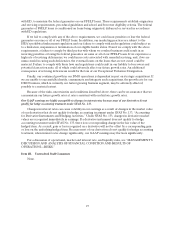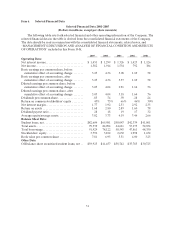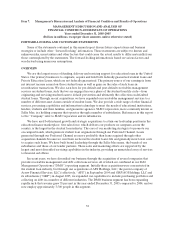Sallie Mae 2005 Annual Report Download - page 32
Download and view the complete annual report
Please find page 32 of the 2005 Sallie Mae annual report below. You can navigate through the pages in the report by either clicking on the pages listed below, or by using the keyword search tool below to find specific information within the annual report.22
Item 1A. Risk Factors
LENDING BUSINESS SEGMENT—FFELP STUDENT LOANS
A larger than expected increase in third party consolidation activity may reduce our FFELP student loan spread,
materially impair our Retained Interest and otherwise materially adversely affect our results of operations.
If third party consolidation activity increases beyond management’s expectations, our FFELP student
loan spread may be adversely affected, our Retained Interest may be materially impaired and our results of
operations may be adversely affected. Our FFELP student loan spread may be adversely affected because
third party consolidators generally target our highest yielding Consolidation Loans. Our Retained Interest
may be materially impaired if consolidation activity reaches levels not anticipated by management. We may
also incur impairment charges if we increase our expected future Constant Prepayment Rate (“CPR”)
assumptions used to value the Residual Interest as a result of such unanticipated levels of consolidation.
The potentially material adverse affect on our operating results relates principally to our hedging activities
in connection with Floor Income. We enter into certain Floor Income Contracts under which we receive an
upfront fee in exchange for our payment of the Floor Income earned on a notional amount of underlying
Consolidation Loans over the life of the Floor Income Contract. If third party consolidation activity that
involves refinancing an existing FFELP Consolidation Loan with a new FFELP Consolidation Loan
increases substantially, then the Floor Income that we are obligated to pay under such Floor Income
Contracts may exceed the Floor Income actually generated from the underlying Consolidation Loans,
possibly to a material extent. In such a scenario, we would either close out the related Floor Income
Contracts or purchase an offsetting hedge. In either case, the adverse impact on both our GAAP and “core
earnings” could be material. (See “MANAGEMENT’S DISCUSSION AND ANALYSIS OF
FINANCIAL CONDITION AND RESULTS OF OPERATIONS—LENDING BUSINESS
SEGMENT—Student Loan Floor Income Contracts.”)
Incorrect estimates and assumptions by management in connection with the preparation of our consolidated
financial statements could adversely affect the reported amounts of assets and liabilities and the reported amounts
of income and expenses.
The preparation of our consolidated financial statements requires management to make certain
critical accounting estimates and assumptions that could affect the reported amounts of assets and
liabilities and the reported amounts of income and expense during the reporting periods. (See
“MANAGEMENT’S DISCUSSION AND ANALYSIS OF FINANCIAL CONDITION AND RESULTS
OF OPERATIONS—CRITICAL ACCOUNTING POLICIES AND ESTIMATES.”) For example, for
both our federally insured and Private Education Loans the unamortized portion of the premiums and the
discounts is included in the carrying value of the student loan on the consolidated balance sheet. We
recognize income on our student loan portfolio based on the expected yield of the student loan after giving
effect to the amortization of purchase premiums and accretion of student loan income discounts, as well as
the impact of Borrower Benefits. In arriving at the expected yield, we must make a number of estimates
that when changed must be reflected as a cumulative student loan catch-up from the inception of the
student loan. The most sensitive estimate for premium and discount amortization is the estimate of the
CPR, which measures the rate at which loans in the portfolio pay before their stated maturity. The CPR is
used in calculating the average life of the portfolio. A number of factors can affect the CPR estimate such
as the rate of Consolidation Loan activity and default rates. If we make an incorrect CPR estimate, the
previously recognized income on our student loan portfolio based on the expected yield of the student loan
will need to be adjusted in the current period.
In addition, the impact of our Borrower Benefits programs, which provide incentives to borrowers to
make timely payments on their loans by allowing for reductions in future interest rates as well as rebates on
outstanding balances, is dependent on the number of borrowers who will eventually qualify for these
benefits. The incentives are offered to attract new borrowers and to improve our borrowers’ payment
behavior. For example, we offer borrowers an incentive program that reduces their interest rate by a


